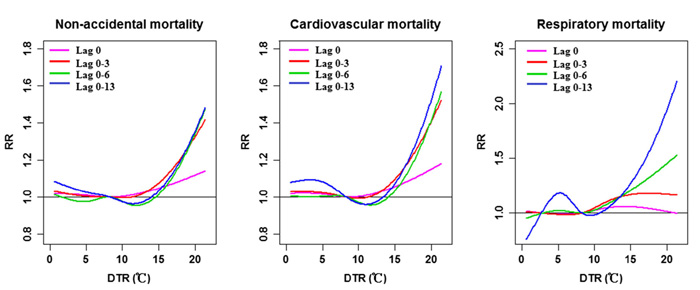| Tweet | Follow @co2science |
Paper Reviewed
Tang, J., Xiao, C., Li, Y., Zhang, J., Zhai, H., Geng, X., Ding, R. and Zhai, J. 2018. Effects of diurnal temperature range on mortality in Hefei city, China. International Journal of Biometeorology 62: 851-860.
DTR is the abbreviation for diurnal temperature range, defined as the difference between maximum and minimum temperatures within a 24-hour period. It is an important indicator of global climate change, with several studies reporting that DTR is declining in most parts of the world.
Writing in a paper recently published in the International Journal of Biometeorology, Tang et al. (2018) note that "several studies have indicated an association between DTR and mortality using statistical models," citing the works of Cheng et al. (2014), Ding et al. (2015; 2016), Xie et al. (2017), Ehelepola and Ariyaratne (2016), Kim et al. (2016), Onozuka and Hagihara (2017) and Zhang et al. (2017). However, they note that few of them have investigated the modifying seasonal effects of DTR on mortality or stratified findings based on age, gender or type of mortality. Thus, it was the objective of this team of eight Chinese scientists to "evaluate the effects of DTR on cause-specific mortality and whether season, gender, or age might modify any association in Hefei city, China, during 2007-2016." Hefei is the capital of Anhui Province in China, with a current population of over 7 million.
To accomplish their work, Tang et al. first obtained daily death counts coded by the cause of death (non-accidental, cardiovascular and respiratory), along with daily meteorological and air pollution data over the ten-year period of analysis. Quasi-Poisson generalized linear regression models combined with a distributed lag non-linear model were then applied to the data so that the researchers could appropriately evaluate the relationships between DTR and non-accidental, cardiovascular and respiratory mortality.
Results indicated there is an independent and non-linear J-shaped association with DTR and daily mortality in Hefei (see figure 1 below). Above a DTR of 8.3°C, the cumulative effects of DTR rose in a non-linear fashion such that the relative risks of extremely high (99th percentile) DTR on non-accidental, cardiovascular and respiratory mortality (with a 0-13 day lag) were 1.14, 1.22 and 1.09. In examining their findings by season, Tang et al. found that relative risks of mortality were highest in spring, but the effects tended to last longer in the winter.
When stratifying their results by age and gender, the scientists report that "male and the elderly (≥ 65 years) were consistently more susceptible to extremely high DTR effect than female and the youth (< 65 years) for non-accidental and cardiovascular mortality," but that "female and youth were more susceptible to extremely high DTR effect than male and the elderly for respiratory mortality."
The significance of the above findings is noted when one recognizes that multiple studies have confirmed that minimum temperatures have been rising predominately faster than maximum temperatures across the globe in recent decades, resulting in a significant decline in DTR worldwide. Consequently, given the relationship between DTR and mortality demonstrated here (and as observed in many other studies of the subject), one can rationally conclude that recent climate change, with its associated reduction in DTR, has helped to save lives. And that data-driven observation is just the opposite of what climate alarmists claim should be occurring due to global warming!

Figure 1. Cumulative effects of DTR on cause-specific mortality over different time lags. Source: Tang et al. (2018).
References
Cheng, J., Xu, Z., Zhu, R., Wang, X., Jin, L., Song, J. and Su, H. 2014. Impact of diurnal temperature range on human health: a systematic review. International Journal of Biometeorology 58: 2011-2024.
Ding, Z., Guo, P., Xie, F., Chu, H., Li, K., Pu, J., Pang, S., Dong, H., Liu, Y., Pi, F. and Zhang, Q. 2015. Impact of diurnal temperature range on mortality in a high plateau area in southwest China: a time series analysis. Science of the Total Environment 526: 358-365.
Ding, Z., Li, L., Xin, L., Pi, F., Dong, W., Wen, Y., Au, W.W. and Zhang, Q. 2016. High diurnal temperature range and mortality: effect modification by individual characteristics and mortality causes in a case-only analysis. Science of the Total Environment 544: 627-634.
Ehelepola, N.D.B. and Ariyaratne, K. 2016. The correlation between dengue incidence and diurnal ranges of temperature of Colombo district, Sri Lanka 2005-2014. Global Health Action 9: 32267.
Kim, J., Shin, J., Lim, Y.H., Honda, Y., Hashizume, M., Guo, Y.L., Kan, H., Yi, S. and Kim, H. 2016. Comprehensive approach to understand the association between diurnal temperature range and mortality in East Asia. Science of the Total Environment 539: 313-321.
Onozuka, D. and Hagihara, A. 2017. Associations of day-to-day temperature change and diurnal temperature range with out-of-hospital cardiac arrest. European Journal of Preventive Cardiology 24: 204-212.
Xie, M.Y., Ni, H., Zhao, D.S., Cheng, J., Wen, L.Y., Li, K.S., Yang, H.H., Wang, S.S., Zhang, H. and Wang, X. 2017. Effect of diurnal temperature range on the outpatient visits for acute bronchitis in children: a time-series study in Hefei, China. Public Health 144: 103-108.
Zhang, Y., Yu, C., Bao, J. and Li, X. 2017. Impact of temperature variation on mortality: an observational study from 12 counties across Hubei Province in China. Science of the Total Environment 587-588: 196-203.
Posted 13 August 2018



